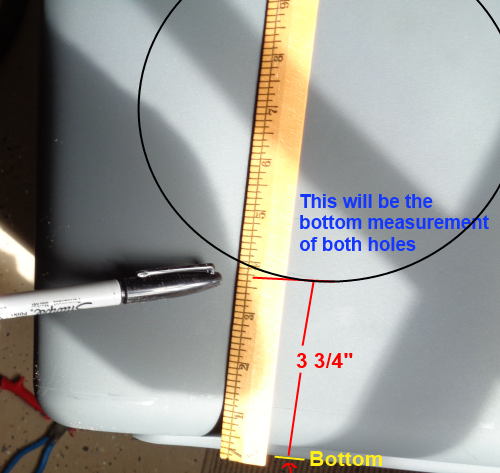

Feral Cat Shelter Building
Cheap, Easy to Make, and Easy to Handle
EducationDx
©2018, 2024
©2018, 2024

Note: You can right click on some items to view an enlarged version
Plastic storage bin with locking latch:
32 1/2 L x 19 3/4 W x 18 5/8"H
32 1/2 L x 19 3/4 W x 18 5/8"H





I started by purchasing a
Sterilite plastic container
. As previously stated, you can use whatever brand you wish. I mention the brand name because I have tried many brands, and this particular container seems to last, appears to be solid and easy to cut. There are others that have these same qualities, and the price played an important role. Note: Shop around for the best price!
Find an area where you can work on the shelter. It can get a little messy, so a garage floor is a nice place where you can work inside regardless of the weather conditions outside.
Sunlight is shining through the garage door lite (glass) projecting the window muntin bar grid on top of the container! (just in case you were wondering what is causing this projection)
Sunlight is shining through the garage door lite (glass) projecting the window muntin bar grid on top of the container! (just in case you were wondering what is causing this projection)

Remember to use eye protection-- and hearing protection when you are drilling!





You will be cutting two (2) holes in the container. One entrance hole on the front and one escape hole on the side.
Both holes will be the same size. The front hole will be cut completely and the side (escape) hole will be cut partially (more on this coming up).
Both holes will be the same size. The front hole will be cut completely and the side (escape) hole will be cut partially (more on this coming up).

I have tried several measurements for the bottom of the hole. This appears to be the optimal height for the average cat. If higher, they have to "jump" over the hole, and if lower, it lets snow and rain enter (water will enter regardless, but this will help.) You can experiment with different heights depending on various factors, e.g., the size of your feral cat(s), amount of snow at your location.
Note: You may find it difficult to estimate the height/weight/"size" of your cat. All of my ferals have been caught (so far!--several dozen), spayed/neutered, shots, and the medical chart gives their weight. They look different when wet or when their fur is puffed up.
As with any height of the entrance hole, snow may block the entrance and escape hole. You need to monitor this and shovel the snow away, just as you would do for any shelter.
Note: You may find it difficult to estimate the height/weight/"size" of your cat. All of my ferals have been caught (so far!--several dozen), spayed/neutered, shots, and the medical chart gives their weight. They look different when wet or when their fur is puffed up.
As with any height of the entrance hole, snow may block the entrance and escape hole. You need to monitor this and shovel the snow away, just as you would do for any shelter.


You can adjust the size of the hole. I tried a little over 6 inch diameter on previous versions, but feel this is a little small, i.e., it keeps out more wind and rain/snow, but doesn't allow for a quick entrance or exit for the cat in case of emergency.

I am using a 7 1/4 inch diameter on this version, and I made an 8 inch version for one of my large (he doesn't like to be called "chubby" cats. Again, you can experiment with the hole size trying to match your cat(s) if you can see them. Most of mine have been here over 4 years, so I see almost everyone everyday when I feed them!
Keep the hole (both side and front) about 2 inches from the side corner.
Note: " symbol means inches Example: 2" means two (2) inches

For example, in the photo to the right, shelter #1 has the entrance hole on the left front, so the escape hole is located on the opposite side towards the rear of the container.
Keep the entrance and "escape" hole 3 3/4" from the shelter bottom and about 2" in from the corner on the front and the sides. You can position the hole to the right or left on the front. The hole on the side (escape hole) should be on the opposite side wall towards the back (not on the back of the container.)

You probably won't buy a hole cutter unless you work on sheet metal projects like your HVAC installer. Unless you plan on making many shelters (over the years) or volunteer at an organization, you might try to borrow one. You can cut a decent hole with the
aviation snips
, and you can find the tool relatively cheap--that you can use again and again.
Lay out your materials and tools nearby, but not in your way. You will need to move the container around to measure, cut, sand and clean.
Hole cutters can be costly,
but cut nice holes and save time!
but cut nice holes and save time!
#1
Drilling the pilot hole for the cat shelter opening!


www.EducationDx.com
Note: Larger computer screens will show larger materials!--and more detail!!
This is a FREE information site!
How to make a
>>PHOTOS and ILLUSTRATIONS on this site<<
Feral Cat Shelter Building
Cheap, Easy to Make, and Easy to Handle
Note: You can right click on some items to view an enlarged version
I started by purchasing a
Sterilite plastic container
. As previously stated, you can use whatever brand you wish. I mention the brand name because I have tried many brands, and this particular container seems to last, appears to be solid and easy to cut. There are others that have these same qualities, and the price played an important role. Note: Shop around for the best price!
Sunlight is shining through the garage door lite (glass) projecting the window muntin bar grid on top of the container! (just in case you were wondering what is causing this projection)
Find an area where you can work on the shelter. It can get a little messy, so a garage floor is a nice place where you can work inside regardless of the weather conditions outside.
Plastic storage bin with locking latch:
32 1/2 L x 19 3/4 W x 18 5/8"H
32 1/2 L x 19 3/4 W x 18 5/8"H



Hole cutters can be costly,
but cut nice holes and save time!
but cut nice holes and save time!
Lay out your materials and tools nearby, but not in your way. You will need to move the container around to measure, cut, sand and clean.

Remember to use eye protection-- and hearing protection when you are drilling!
You probably won't buy a hole cutter unless you work on sheet metal projects like your HVAC installer. Unless you plan on making many shelters (over the years) or volunteer at an organization, you might try to borrow one. You can cut a decent hole with the
aviation snips
, and you can find the tool relatively cheap--that you can use again and again.

I have tried several measurements for the bottom of the hole. This appears to be the optimal height for the average cat. If higher, they have to "jump" over the hole, and if lower, it lets snow and rain enter (water will enter regardless, but this will help.) You can experiment with different heights depending on various factors, e.g., the size of your feral cat(s), amount of snow at your location.
Note: You may find it difficult to estimate the height/weight/"size" of your cat. All of my ferals have been caught (so far!--several dozen), spayed/neutered, shots, and the medical chart gives their weight. They look different when wet or when their fur is puffed up.
As with any height of the entrance hole, snow may block the entrance and escape hole. You need to monitor this and shovel the snow away, just as you would do for any shelter.
Note: You may find it difficult to estimate the height/weight/"size" of your cat. All of my ferals have been caught (so far!--several dozen), spayed/neutered, shots, and the medical chart gives their weight. They look different when wet or when their fur is puffed up.
As with any height of the entrance hole, snow may block the entrance and escape hole. You need to monitor this and shovel the snow away, just as you would do for any shelter.

You will be cutting two (2) holes in the container. One entrance hole on the front and one escape hole on the side.
Both holes will be the same size. The front hole will be cut completely and the side (escape) hole will be cut partially (more on this coming up).
Both holes will be the same size. The front hole will be cut completely and the side (escape) hole will be cut partially (more on this coming up).



Keep the hole (both side and front) about 2 inches from the side corner.
I am using a 7 1/4 inch diameter on this version, and I made an 8 inch version for one of my large (he doesn't like to be called "chubby" cats. Again, you can experiment with the hole size trying to match your cat(s) if you can see them. Most of mine have been here over 4 years, so I see almost everyone everyday when I feed them!

You can adjust the size of the hole. I tried a little over 6 inch diameter on previous versions, but feel this is a little small, i.e., it keeps out more wind and rain/snow, but doesn't allow for a quick entrance or exit for the cat in case of emergency.

Keep the entrance and "escape" hole 3 3/4" from the shelter bottom and about 2" in from the corner on the front and the sides. You can position the hole to the right or left on the front. The hole on the side (escape hole) should be on the opposite side wall towards the back (not on the back of the container.)
For example, in the photo to the above, shelter #1 has the entrance hole on the left front, so the escape hole is located on the opposite side towards the rear of the container.

#1
Drilling the pilot hole for the cat shelter opening!
EducationDx
©2018, 2024
©2018, 2024


>>PHOTOS and ILLUSTRATIONS on this site<<
This is a FREE information site!
Part of EdDx Educational Series
Part of EdDx Educational Series
How to make a
www.EducationDx.com

*Disclosure: Some links on this website are associate links and are used to help illustrate what an item looks like, and you can decide if you want to just look or purchase the item. "As an Amazon Associate, I earn from qualifying purchases." We receive a small commission (that helps support this website) if you actually purchase from this company, but the price to you remains the same.
You can hover over any link to see if it is an Amazon link, if this matters, or a link to a page on this website or to a reference page, e.g., Smithsonian Institution, bookmark on this website, etc.
You can hover over any link to see if it is an Amazon link, if this matters, or a link to a page on this website or to a reference page, e.g., Smithsonian Institution, bookmark on this website, etc.
*Disclosure: Some links on this website are associate links and are used to help illustrate what an item looks like, and you can decide if you want to just look or purchase the item. "As an Amazon Associate, I earn from qualifying purchases." We receive a small commission (that helps support this website) if you actually purchase from this company, but the price to you remains the same.
You can hover over any link to see if it is an Amazon link, if this matters, or a link to a page on this website or to a reference page, e.g., Smithsonian Institution, bookmark on this website, etc.
You can hover over any link to see if it is an Amazon link, if this matters, or a link to a page on this website or to a reference page, e.g., Smithsonian Institution, bookmark on this website, etc.
Sponsored Link
Sponsored Link